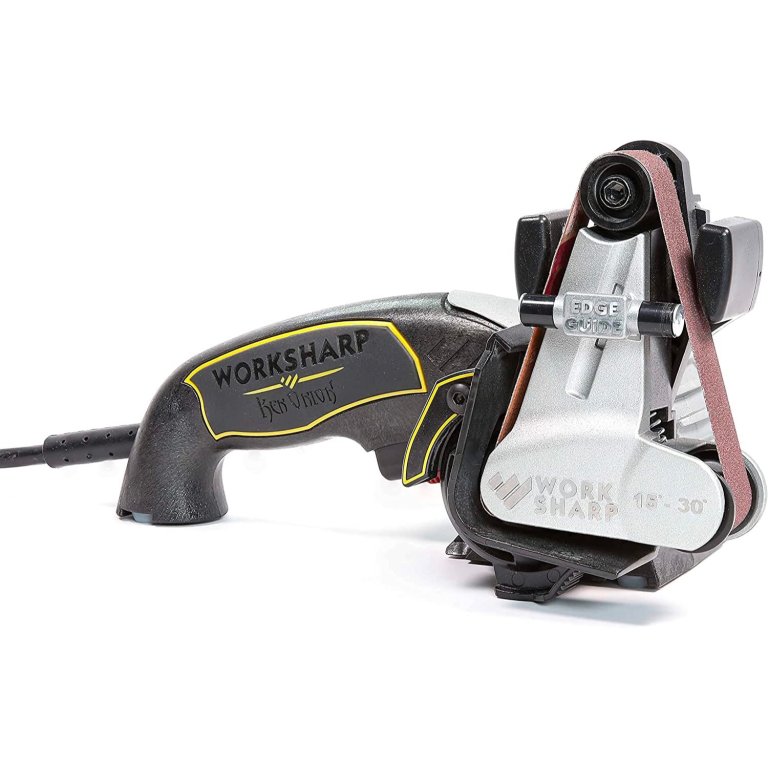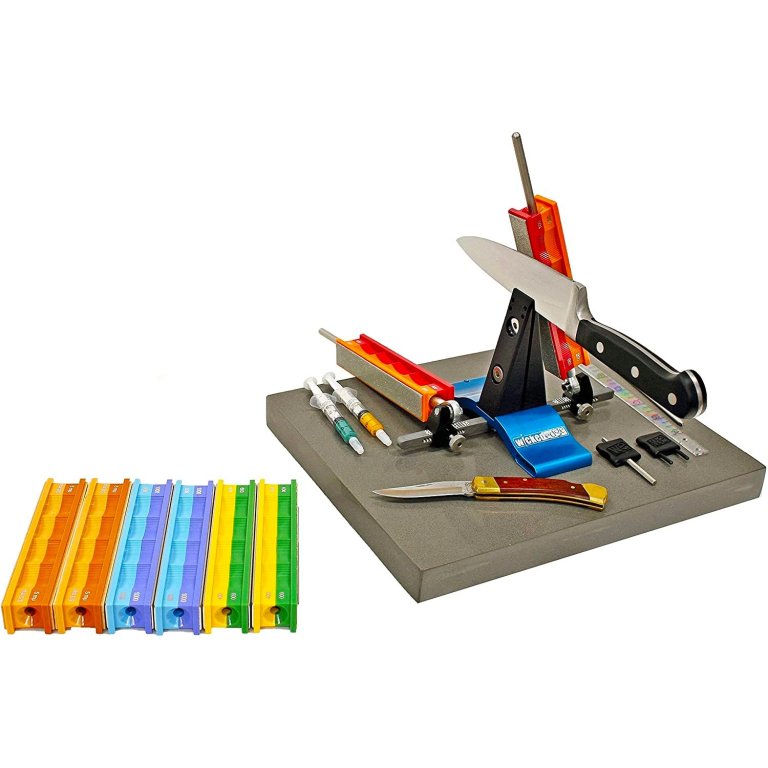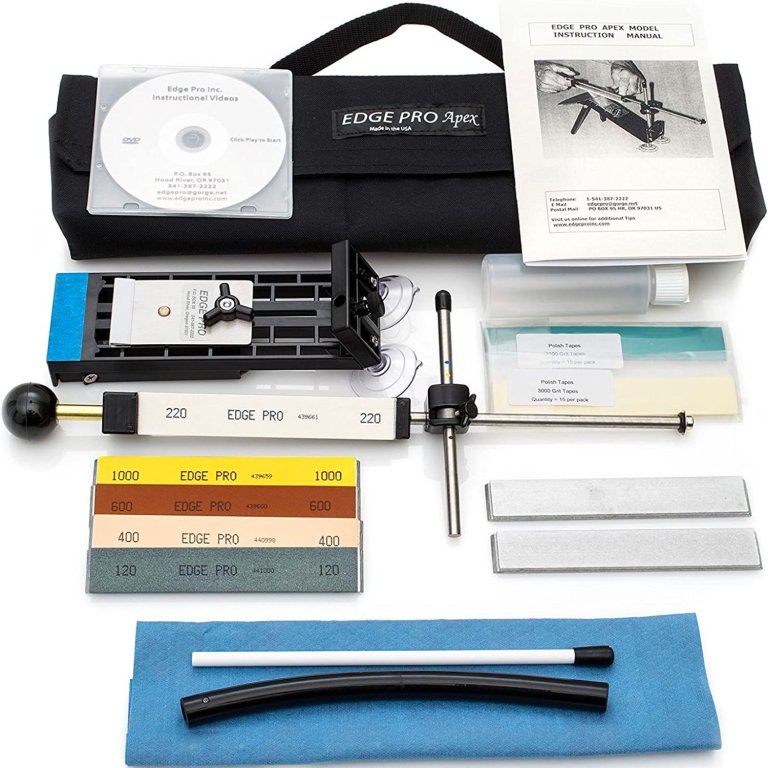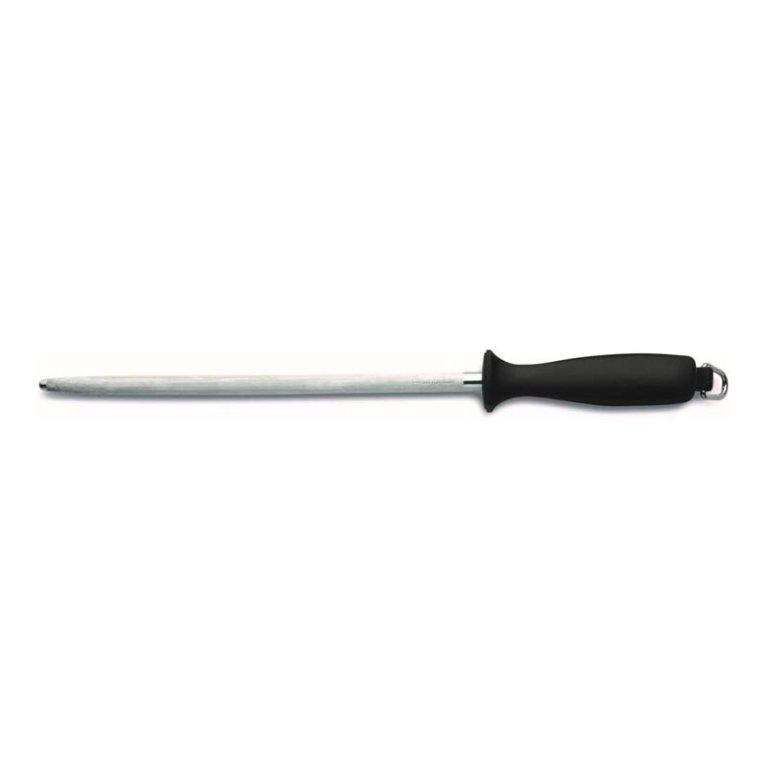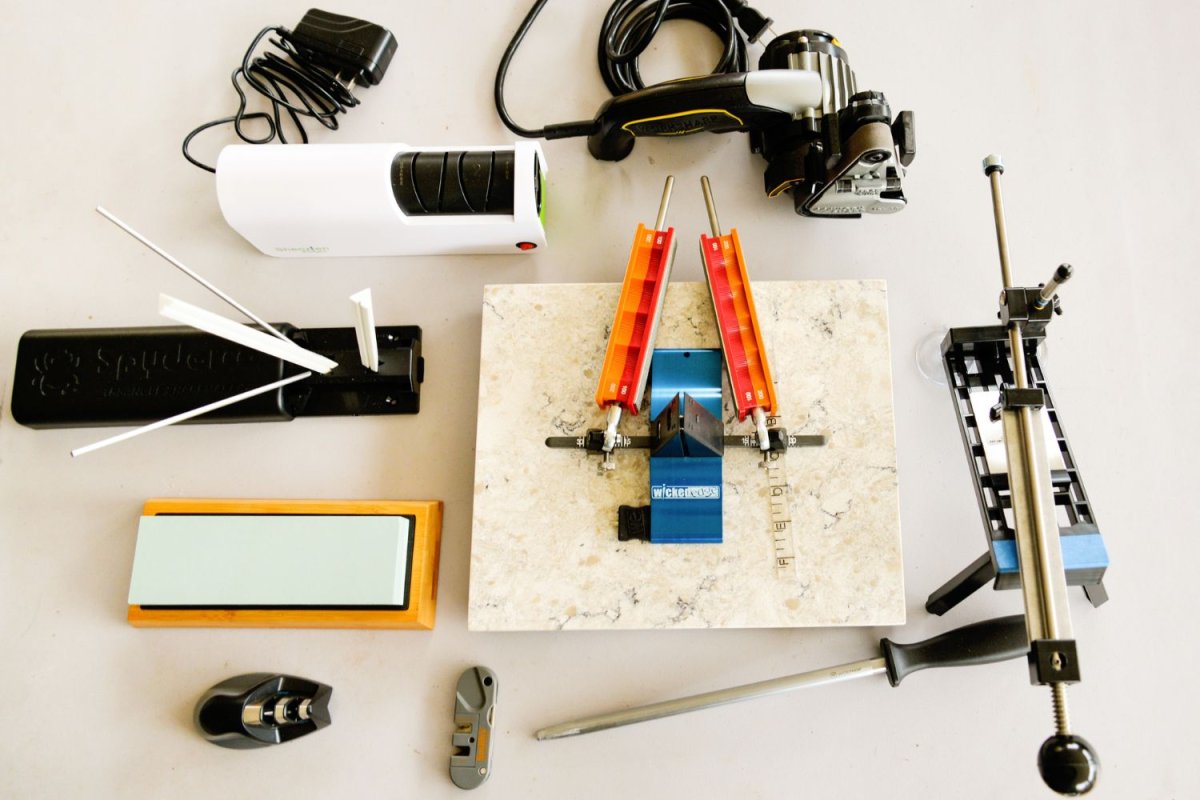
We may earn revenue from the products available on this page and participate in affiliate programs. Learn More ›
Knives are among the most essential tools for gardening, DIY projects, food prep, and more. And the sharper they are, the better and safer they function. A high-quality knife sharpener belongs in every home to keep kitchen knives, pocket knives, and multi-tool blades in top condition.
The ability to sharpen a knife is a highly valuable skill, and it takes a quality tool to do it right. We researched the most popular knife sharpeners from the top manufacturers in the industry to assemble a list of contenders, and then tested our top picks to find out how they truly perform. Find out more about the best knife sharpeners and which model may be right for you.
- BEST OVERALL ELECTRIC: Work Sharp Power Knife & Tool Sharpener
- BEST OVERALL MANUAL: Wicked Edge Pro-Pack I Knife Sharpening Package
- BEST BANG FOR THE BUCK: KitchenIQ Edge Grip 2-Stage Knife Sharpener
- BEST PORTABLE: Edge Pro Apex 4 Knife Sharpening System
- BEST STONE: KnifePlanet Premium Knife Sharpening Stone Set
- BEST SHARPENING STEEL: Wüsthof 10″ Knife Honing Steel With Loop
- BEST FOR CERAMIC KNIVES: Shenzhen Knives Electric Diamond Knife Sharpener
- BEST FOR POCKET KNIVES: Smith’s Pocket Pal Knife Sharpener
- ALSO CONSIDER: Spyderco Tri-Angle Sharpmaker
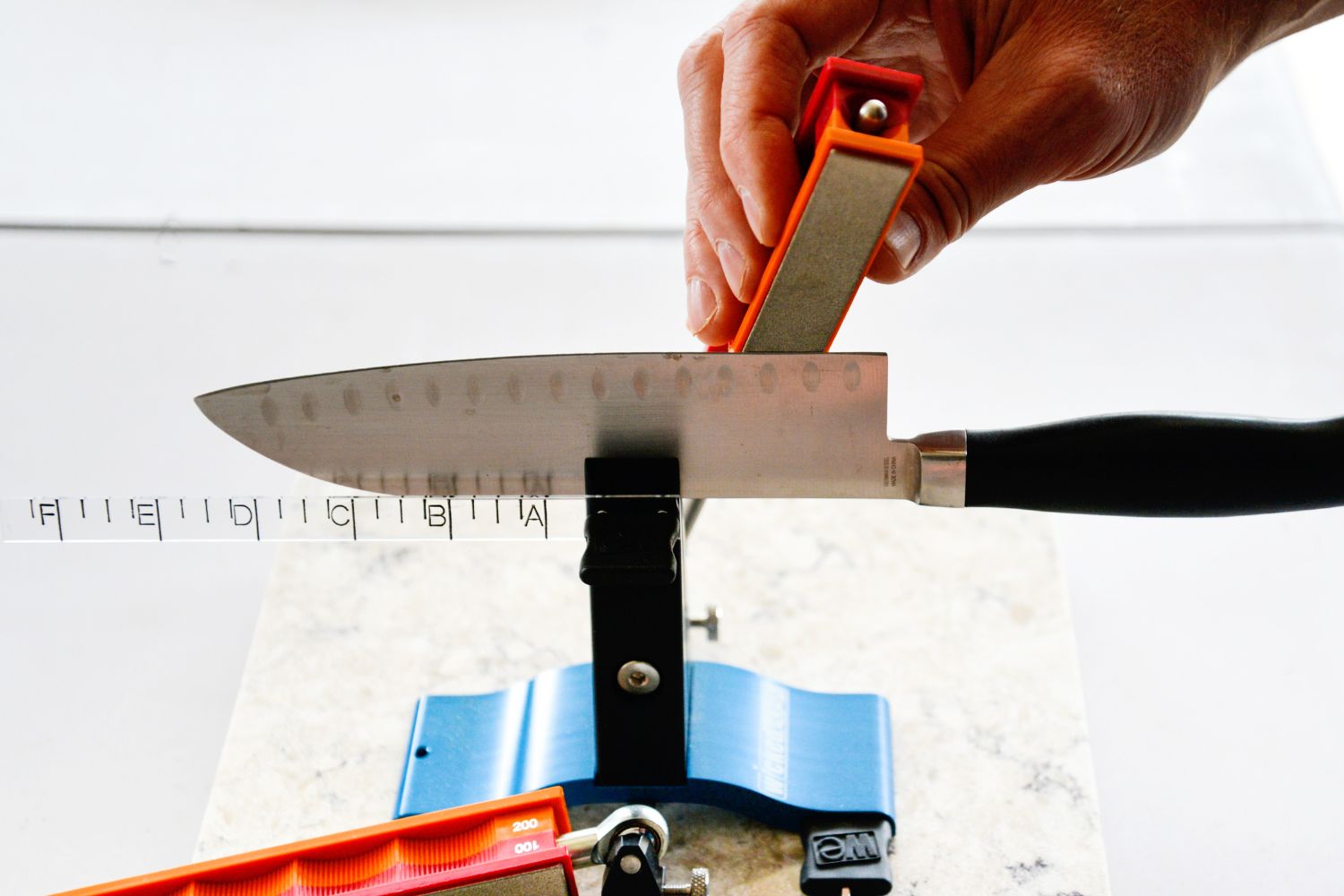
Types of Knife Sharpeners
Just as there are many types of knives, there are quite a few ways to sharpen them. Here, learn how different knife sharpeners work and compare their pros and cons. Some of these methods are ancient, while others represent a new wave of precision sharpening.
Whetstones
Whetstonesare the classic and most-preferred manual method for sharpening kitchen knives. These perfectly flat sharpening stones have a gritty surface across which the user drags a knife’s cutting edge. This reshapes the cutting edge by removing any misshapen metal. Potentially, users can even customize a knife’s grind angle with a whetstone faster than with other sharpener types.
Whetstones come in a variety of grits and can provide remarkably sharp results. The user starts sharpening with the coarsest grit and works toward the finest. When done correctly, the knife can gain a razor-sharp edge. Just be aware that this method is slow and requires more patience and expertise than others.
V-Notch Sharpeners
Much faster and simpler to use than a whetstone, V-notch sharpeners have hardened materials (typically ceramic or carbide) installed in a preset V-shape that’s set into a notch in plastic housing. The knife is dragged from heel to tip through the notch, allowing the sharpening material to remove metal until the knife conforms to its preset angle (also known as the grind).
Different grind angles provide different characteristics, such as how long a knife maintains its edge or how easily it cuts through delicate material. V-notch knife sharpener angles are preset, however, so users cannot choose the profile to put on the knives. V-notch sharpeners also tend to leave a rougher edge on the blade than other methods.
Honing Rods
Rather than removing material, honing rods smooth out the microscopic nicks and dents that come with normal use or even after careful grinding.Although also referred to as sharpening steels, these implements can’t help a severely dulled blade; instead, regular use will complement sharpening for the keenest edge a knife can get. To hone a knife, drag the blade across the rod from heel to point while maintaining the grind angle as closely as possible. (See below for more information on honing.)
Electric Sharpeners
Electric knife sharpeners are typically the fastest way to put an accurate grind on a knife’s edge. Designed to sit on a countertop, electric knife sharpeners feature a succession of grinding wheels and angled grooves through which the user pulls the knife. The knife becomes sharper as it works its way through the stages.
Though electric knife sharpeners are easy to use and relatively foolproof, they tend to be pricey and don’t provide any grind-angle flexibility. They’re not as compact as manual sharpeners, but most are relatively small enough to be stored in a kitchen drawer.
What to Consider When Choosing the Best Knife Sharpener
Before buying a knife sharpener, bone up on the difference between sharpening and honing as well as various key factors and features—including material, suitability, and safety—of these precision tools.
Sharpening vs. Honing
Sharpening and honing are not interchangeable terms. They are different tasks that complement each other to keep knife blades keen. Each method requires a tool.
- Sharpening removes metal from a dull blade to create the ideal angle (also known as the profile or grind). Although this process alone will restore sharpness, grinding itself can leave microscopic nicks on the blade’s edge. That’s where honing comes in.
- Honing a blade smoothes the surface. A honing rod will smooth any nicks and dents out of the blade, creating a perfectly tuned blade edge. A quick honing after the sharpening process will yield a sharp, smooth edge.
Suitability
Most sharpeners can handle a variety of knife sizes, but it’s wise to check which blade type and grind angle a sharpener can service. Standard blades tend to come with 20-degree grind angles, which are durable and easy to maintain with a whetstone and honing rod.
Most pull-through V-notch systems sharpen at preset 18- or 22-degree angles. An 18-degree angle is sharp but will require more frequent sharpening, ultimately reducing the life of the blade. Electric sharpeners usually sharpen at 15- to 20-degree angles.
To sharpen serrated knives and ceramic knives, look for a model that specifically states its suitability for these blades. Using a standard sharpener on a serrated or ceramic blade will drastically reduce the useful life of the knife.
Material
For centuries, whetstones were actual pieces of gritty rock, but most of today’s models are synthetic combinations of abrasives. These abrasives include alumina oxide, sapphirite, silicon carbide or other ceramics, and diamond. Many of the best knife-sharpener kits have a combination of these materials in different grit sizes, though some models might use different (though similar) materials.
Depending on the sharpener, these materials come in different shapes. For instance, a whetstone is one piece shaped like a block, a rod, or a puck. In V-notch sharpeners, the sharpening materials might be opposing strips that look somewhat like blades or cylindrical rods (not to be confused with honing rods). With electric sharpeners, the sharpening materials are usually shaped like wheels that are typically housed within the machine for safety.
Safety
When working with sharp blades, safety is a top priority. Some sharpening methods, such as electric and pull-through countertop models, are inherently safer options. They typically have a nonslip bottom that helps keep the tool in place while sharpening a knife.
Many kits come with safety gloves intended to be worn on the hand that holds the sharpener. These gloves will minimize—but not eliminate—the chances of accidentally slicing a finger while pulling a blade through the sharpener.
Oversize guards are also popular on the best pull-through knife sharpener options. These molded guards prevent users from placing their hands too close to the sharpening surface, minimizing the chance of knife-to-skin contact while sharpening dull knives.
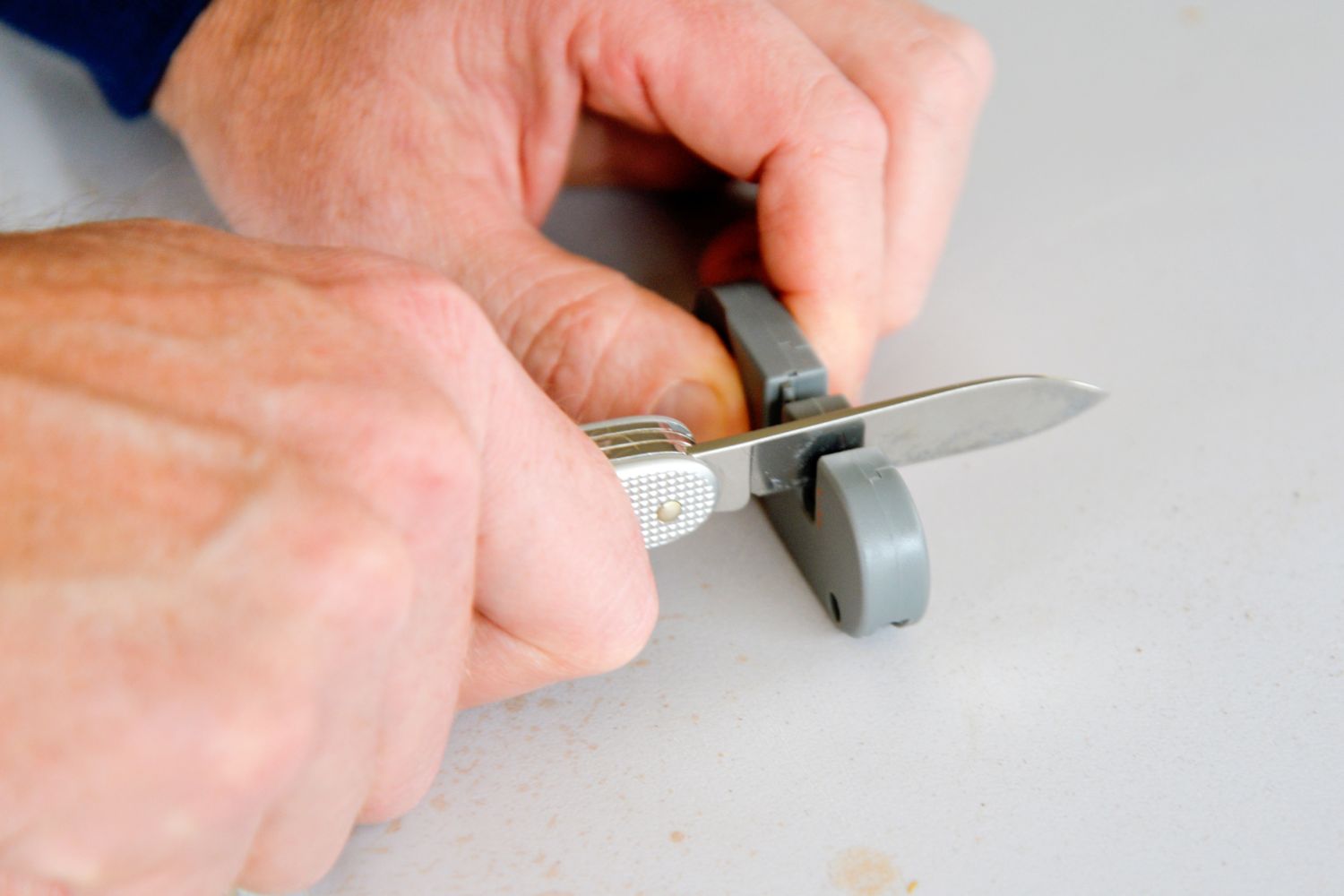
Our Top Picks
We used the above background information and details about knife sharpeners to select our list of products for testing. Ahead, find out how each product performed and why we believe they deserve consideration as some of the best knife sharpeners available.
Best Overall Electric
Work Sharp Power Knife & Tool Sharpener
Pros
- Quick and easy to set the right sharpening angle for most knives and tools between 15 and 30 degrees
- Custom designed synthetic abrasives are created specifically for sharpening high-end steel
- Includes 5 long-lasting abrasive belts that rarely need to be replaced
- Variable-speed motor offers great control over sharpening and improves efficiency
Cons
- Belts must be changed multiple times for every sharpening session
- Not suitable for use in the kitchen because operation spreads metal dust
Product Specs
- Type: Electric sharpener
- Material: Synthetic abrasive belts
- Sharpening vs. honing: Both
The Work Sharp Power Knife & Tool Sharpener is essentially a small benchtop belt grinder engineered specifically for sharpening knives and tools. It features nonskid feet, a variable-speed trigger, an edge guard for improved consistency, and an adjustable angle guide for precision blade profiling between 15 and 30 degrees. The five included abrasive belts were custom designed for sharpening high-end knife steel. The adjustable rotating cassette allows users to sharpen scissors and other tools in addition to knives of all shapes and sizes.
We really liked the fast-working design of the Work Sharp knife and tool sharpener. It operated more quietly and efficiently than other electric models. With only four to six strokes per side on progressively finer-grit belts, we completely renewed a damaged and dull chef’s knife in about 5 minutes. The finest grit belt honed the edge to a mirrorlike finish.
Although this tool has the potential to grind knives too aggressively at high speed, the adjustable speed switch made it possible to work at a comfortable pace without damaging blades. (High-speed operation is best reserved for sharpening thick blades like scissors or shop tools.) Angle adjustments and belt changes were easy to accomplish and intuitively designed. One word of caution, however, is that the tool spreads fine metal dust, so it is best operated in a workshop-type environment, not a kitchen countertop.
Get the Work Sharp knife sharpener at Northern Tool + Equipment or Rockler.
Best Overall Manual
Wicked Edge Pro-Pack I Knife Sharpening Package
Pros
- Included diamond stones and leather strops produce a razor-sharp edge
- Clamp-and-rod system makes it easy to get excellent, repeatable results
- Extra-coarse stones quickly renew the bevel on extremely dull knives
- Leather strops with diamond paste polish knife edges to a mirror finish
Cons
- Premium price point for a high-end tool
- Assembly and initial start-up are somewhat complicated
- Large sharpening system must be partially or fully disassembled for storage
Product Specs
- Type: Whetstone
- Material: Diamond
- Sharpening vs. honing: Both
The Wicked Edge Pro knife sharpening system allows users to sharpen knives quickly to an incredibly sharp edge with repeatable consistency. The whetstone kit includes a predrilled quartz base with nonskid rubber feet to which the clamp and ball-joint rod assembly are affixed by screws. Six double-sided diamond-grit stones with extra-coarse through extra-fine grits are capable of reprofiling any blade and sharpening to a razor edge. Two strops polish the blade to a mirror-smooth finish. The included depth gauge and clamp pin allow users to replicate custom results for any blade.
Admittedly, the Wicked Edge Pro system was the heaviest and most complicated to assemble of all the knife sharpeners we tested. We had to attach the clamp to the quartz base with screws, add rubber feet to the base, attach the ball-joint rods to the clamp arms, and then figure out how to set up a knife in the clamp properly. Although it took 15 minutes to assemble and another 15 minutes to figure out how to use it, the tool finally delivered fast, consistent results. After a little practice, we used it to return an old carving knife to like-new condition.
We especially liked that the depth gauge and stopper pin allowed us to position a knife in the clamp exactly the same way every time. Also, because the double-sided stones simply slide down onto the rods, changing grits was fast and easy. Starting with the 100-grit stone, we reprofiled our blade to 20 degrees with just 10 strokes per side. We then progressed through the 200-, 400-, 600-, 800-, and 1,000-grit stones at four to five strokes per side before honing with the 4,000- and 8,000-grit strops. Actual sharpening time was about 10 minutes.
While this mess-free system could work just fine on the kitchen counter, it takes up about 1 square foot of real estate. Storage is another consideration that should be factored in, since the unit is big and weighs almost 18 pounds with the base. The tool can be disassembled and stored in the box, but frequent users may prefer to create a dedicated workstation.
Get the Wicked Edge knife sharpener on Amazon, SharpeningSupplies.com, or North River Outdoors.
Best Bang for the Buck
KitchenIQ Edge Grip 2-Stage Knife Sharpener
Pros
- A 2-stage sharpener; resurfaces the knife edge and smooths the bur
- Compact design easily fits into a kitchen drawer
- Versatile option; works on straight and serrated knives
- Cushioned handle design offers user comfort with less slippage
Cons
- One-size-fits-all approach; does not work for every blade bevel
Product Specs
- Type: V-notch
- Material: Carbide and ceramic
- Sharpening vs. honing: Sharpening
Home chefs and knife collectors hoping to sharpen their valuable knives without breaking the bank should look into KitchenIQ’s Edge Grip 2-Stage Knife Sharpener. This compact pull-through sharpener features a budget-friendly price tag and a simple, guess-free sharpening system.
The KitchenIQ Edge Grip manual knife sharpener has two sharpening slots with preset angles to make consistent, repetitive sharpening a breeze. The coarse side will reshape a damaged edge, while the fine side can handle regular smoothing of the rough edge as well as maintenance. This knife sharpener features a handle section to keep the user’s hand safe from the blades while also allowing a sure grip on the device.
In our tests, this simple V-notch knife sharpener proved easy to use and surprisingly effective for sharpening moderately dull blades. Ten strokes in the carbide notch removed the rough edges on a well-used paring knife and chef’s knife before we smoothed them out in the ceramic notch. The edge of the paring knife had a deep pit that this sharpener could not remove, but the rest of the blade was well sharpened.
The edge-grip feature made it easy to work right at the edge of the countertop so that our knuckles avoided collision with the surface. This is not the tool for rejuvenating abused or neglected blades, but it makes a handy tool for quick maintenance when serious grinding is not necessary.
Get the KitchenIQ knife sharpener at Amazon or Wayfair.
Best Portable
Edge Pro Apex 4 Knife Sharpening System
Pros
- Compact, lightweight sharpening system in a convenient Cordura carry case
- Includes 120-, 220-, 400-, 600-, and 1,000-grit whetstones to sharpen even the dullest knives
- Support table holds the blade at a consistent angle to define the edge bevel efficiently
Cons
- Some practice is required to master the movements of the knife and sharpener
- Suction cups on the base may not be compatible with all work surfaces
Product Specs
- Type: Whetstone
- Material: Ceramic
- Sharpening vs. honing: Both
With its collapsible ABS plastic sharpening table and single-pivot whetstone rod, the Edge Pro Apex 4 sharpening system is highly portable. The kit includes five sharpening stones, two polishing stones, an 8-inch ceramic hone, and a small water bottle and towel for easy cleanup, all in a heavy-duty Cordura carry case. It packs into a conveniently low profile and weighs less than 3 pounds for easy transport wherever knives need to be sharpened.
Setting up the Edge Pro Apex 4 was a breeze, but it seemed to have the steepest learning curve of all the models we tested. Fortunately, the instructional video was extremely helpful! After practicing on a few blades, we were easily able to produce similar impressive results with this tool as with our Best Overall Manual pick—only somewhat slower and at half the price. Initially, we disliked that the blade was not fixed to the sloped sharpening table, but ultimately we realized that this allows flexibility of movement while sharpening and resulted in a smoother, more consistent profile.
We used this tool to renew a well-worn 10-inch carving knife and to sharpen two pocket knives. The pocket knives were somewhat challenging due to their short blades and unbalanced structure, but the long carving blade was a breeze to sharpen. Beginning with the 120-grit whetstone, we renewed the edge profile before quickly working through the 220-, 400-, 600-, and 1,000-grit stones, and finally honing the blade with the 2,000- and 3,000-grit polishing tape. The formerly neglected blade came out supersharp.
Forgiving the fact that blades must be repositioned multiple times while working with this tool, we grew to appreciate it. Our earlier concerns about the knife slipping out and slicing a knuckle proved unfounded. Stops on the pivot rod and the way that blades balance on the sharpening table prevented those problems. Plus, the Edge Pro Apex only weighs a few pounds, and its heavy-duty nylon carry case made it the most “carryable” of the group.
Get the Edge Pro at Amazon or Knife Center.
Best Stone
KnifePlanet Premium Knife Sharpening Stone Set
Pros
- A 4-stage grinding system includes 400-; 1,000-; 3,000-; and 8,000-grit stones
- Includes 2 double-sided water stones and a flattening stone
- Blade angle guide and bamboo base with nonslip pad round out the package
Cons
- Extremely dull blades will require a longer time working with the 400-grit stone
Product Specs
- Type: Whetstone
- Material: Silicon carbide and alumina oxide
- Sharpening vs. honing: Sharpening
The KnifePlanet Premium Knife Sharpening Stone Set offers a great tool to give favorite knives an ideal edge. It comes with a set of two sharpening stones, a bamboo base, a flattening stone, and two rubber nonslip bases. The two stones each have two grits: 400/1000 and 3000/8000. This four-stage grinding process adds up to a near-perfect grind when used properly.
The kit also includes a flattening stone to keep the whetstones in good working order. Whetstones tend to become wavy after several uses, as sharpening not only removes material from the knife but also the stone. Use the flattening stone to level the whetstone and increase its lifespan.
While practice is required for the best, most consistent results, the KnifePlanet sharpening stone set proved to be the simplest, most versatile choice for the broadest range of sharpening needs. We used the 400/800-grit stone to sharpen pocket knives, a 10-inch chef’s knife, a pair of fabric scissors, and an 18-inch garden machete. To further tune the edges, we followed up with the 3,000/8,000-grit stones. The stones are made of a soft material that creates a gritty sludge on the surface while working, which is normal but a bit messy.
The nonskid bamboo base and rubber stone holder secured the stones throughout the process. After sharpening all of the blades previously mentioned, we used the flattening stone to recondition the surfaces of the sharpening stones. That process took between 10 and 15 minutes per side, and the surfaces were like new. Those looking for versatility, or who prefer to sharpen their blades the old-fashioned way, would appreciate this set.
Get the KnifePlanet knife sharpener on Amazon, Etsy, or KnifePlanet.
Best Sharpening Steel
Wüsthof 10" Knife Honing Steel With Loop
Pros
- The 10-inch sharpening steel lightly sharpens and hones most kitchen knives
- Slip-resistant handle features a square profile for better control
- Magnetized steel retains metal fibers to hone more effectively
- Includes a steel loop at the base of the handle for hanging the rod
Cons
- Honing steels are not designed to sharpen extremely dull knives
- Cheap-looking plastic handle lacks the red Wüsthof logo and so may not precisely match the look of some Wüsthof knives
Product Specs
- Type: Honing rod
- Material: Alloy steel
- Sharpening vs. honing: Mostly honing, but will lightly sharpen
Anyone on the hunt for a high-quality honing rod should check out this Wüsthof model. This steel is 10 inches long, providing plenty of honing surface for large knives. It has a plastic slip-resistant handle for quick and easy sharpening.
This model is also magnetized to attract metal fibers during use, ensuring that the blade is sharp and ready for use right away. The loop on the bottom of the handle affords a convenient way to keep the Wüsthof on hand and nearby in the kitchen.
We tested the Wüsthof steel on all of our kitchen knives as well as several pocket knives. It honed newly sharpened blades to a keen, shiny edge. On blades that had been used several times since their last proper sharpening, this steel trued the blade edges nicely to improve slicing and chopping action.
We did not love the plastic handle, however. It cheapened the feel and appearance a bit and did not match some of the other more substantial Wüsthof knife handles in our test group. Still, for pure function, we recommend this tool as one of the best.
Get the Wüsthof honing steel at Amazon or WebstaurantStore.
Best for Ceramic Knives
Shenzhen Knives Electric Diamond Knife Sharpener
Pros
- Plug-in electric grinding wheels quickly create a sharp edge on dull blades
- Grind angles of 18 and 20 degrees suitable for ceramic and stainless steel knives
- Lightweight, compact, and easy to clean up, so convenient for kitchen usage
Cons
- Not much difference between coarse (600-grit) and fine (800-grit) sharpening
- Tool is not suitable for scissors or hunting, pocket, and folding knives
Product Specs
- Type: Electric
- Material: Diamond grits
- Sharpening vs. honing: Sharpening
Sharpening ceramic knives requires a more precise, delicate touch than sharpening stainless or high-carbon blades might. Shenzhen Knives’ Electric Diamond Knife Sharpener is up to the task with diamond grinding specially designed for ceramic blades.
This knife sharpener features a plug-in electric grinding wheel with coarse and fine diamond grits. The coarse slots feature an 18-degree grind angle, and the fine slots bring the blade to a final point of 20 degrees, sharpening ceramic blades without making them too brittle. It does a fine, fast job on ceramic blades, and it easily sharpens stainless steel kitchen, pocket, and outdoor knives, too.
In our tests, the Shenzhen Knives electric sharpener proved to be an inexpensive option for repairing and sharpening chipped ceramic knives. We started testing with a ceramic knife that had several chips along the edge, ranging from about 0.5 millimeter to a little more than 1 millimeter. By lightly and slowly gliding the blade through the coarse sharpener 14 times, we removed the chips and started a new profile. Another half dozen strokes in the fine sharpener and the knife was well sharpened to cut properly. The removeable diamond wheel cartridge makes the tool easy to clean and can one day be replaced when the wheels no longer sharpen effectively.
Get the Shenzhen knife sharpener at Amazon.
Best for Pocket Knives
Smith’s Pocket Pal Knife Sharpener
Pros
- Lightweight and packable, the tool is perfectly designed for camping, fishing, or hunting
- Includes a diamond rod for sharpening serrations, a coarse carbide notch, and a ceramic finishing notch
- Carbide and ceramic stones are reversible and replaceable for extended working life
Cons
- Sharpening angle is not adjustable for different blades (22.5 degrees)
- Not practical for reprofiling or resharpening extremely dull blades
Product Specs
- Type: V-notch
- Material: Carbide and ceramic
- Sharpening vs. honing: Both
The Smith’s Pocket Pal V-notch sharpener makes it easy to maintain a sharp blade at work, in camp, or on the go. At just 3.5 inches long, 1 inch high, and weighing less than 1 ounce, it ought to go completely unnoticed in a pocket or backpack. It includes a coarse carbide notch for creating a quick edge and a ceramic notch for an extra-sharp edge. The preset angles are ideal for maintaining the edge profiles of outdoor knives and pocket knives. The carbide and ceramic inserts are reversible and replaceable for an extended working life. For serrated knives, it also includes a fold-out round, tapered, diamond-coated rod.
We tested the Pocket Pal on several pocket knives and found it to be an excellent choice. Carbon-steel blades responded more quickly than stainless steel, but we were able to hone nice sharp edges on all types we tested. We simply held the sharpener on its edge and stroked the knife through each slot a few times, starting with the carbide side and finishing with the ceramic side.
We also tested the diamond rod on the serrations of an old bread knife, and it made a nice edge. Even severely damaged blades were temporarily improved, but this tool cannot reprofile a fully blunted edge. This model is great for routine maintenance during heavy use or to improve an edge temporarily.
Get the Smith’s knife sharpener at Amazon or Scheels.
Also Consider
Spyderco Tri-Angle Sharpmaker
Pros
- An easy system for novices to learn on; quickly sharpens dull knives
- Includes coarse-grit and fine-grit sharpening rods and a base with 2 sets of preset angles
- Sharpening base doubles as a compact storage and carry case for easy transport
Cons
- Numerous accessories, such as diamond rods, are sold separately
- Similar systems from other brands sell for about half the price
Product Specs
- Type: Whetstone
- Material: Alumina oxide and ceramic
- Sharpening vs. honing: Sharpening
Another longtime favorite of blade enthusiasts, the Spyderco Tri-Angle Sharpmaker has been around for decades. Its popularity stems from a combination of lightweight portability, ease of use, and effectiveness producing a razor-sharp edge.
The kit includes two coarse sharpening stones, two fine sharpening stones, and two aluminum rods to protect the user’s hands, all packed into a rugged ABS plastic carry case that doubles as the sharpening base. The base is keyed to insert the stones for two sharpening configurations: one for 20-degree profiles and the other for 15-degree profiles.
We tested the Sharpmaker on a variety of large and small knives, including a few with serrated edges. Although this system offers no “guarantees” of a perfectly aligned edge profile in terms of an angled notch or clamp-and-pivot like other systems we tested, it was incredibly easy to use and produced razor-sharp edges for us.
After selecting the keyed holes in the base for our desired angle, we inserted the brown (coarse) stones for the first portion of sharpening and then finished up with the white (fine) stones. To sharpen a blade, we simply held it vertically as we drew it down and across the angled stones, alternating sides at each stroke. For most average blades, six to 10 strokes per side on each stone was adequate. Some of the especially dull blades needed extra strokes on the coarse stone. To finish the edge, we simply applied less pressure (almost none) while drawing against the white stones.
While it was not perfect, this affordable system provided outstanding overall results. We would not recommend using it to reprofile a damaged blade, but it can handle all but the worst cases. And the handy carry case makes it easy to store, pack, and set up pretty much anywhere.
Get the Spyderco knife sharpener at Amazon or KnifeCenter.
Our Verdict
Sharp knives help prevent accidents and injuries and give us greater work satisfaction, so maintaining blades should be a priority. Our Best Overall Electric pick, the Work Sharp knife sharpener, makes it easy to keep all kinds of knives sharp as well as to renew old blades quickly. (Caveat: We don’t recommend it for working in the kitchen.) For those who want to keep a small, inexpensive sharpener at the ready for a quick touch up, we recommend the KitchenIQ knife sharpener.
How We Tested the Best Knife Sharpeners
In our search for the best knife sharpeners, we researched the most sought-after electric, whetstone, V-notch, and honing models. We poured over hundreds of verified customer reviews of more than 40 different knife-sharpening tools and systems from 23 of the most respected brands in the industry. After weighing the pros and cons of various design features, abrasive materials, and compatibility for different sharpening applications, we narrowed our list to the picks mentioned in this guide. Then we tested them.
We gathered an assortment of thrift-shop finds, including chef’s knives, carving knives, serrated knives, and pocket knives, and dulled the edges on those that were not already beaten up. To ensure the nonusefulness of the knives prior to testing, we attempted to cut an apple, tomato, or crusty bread; none of the knives were up to the task.
We are not professional knife sharpeners, which should lend some confidence to readers who may not feel confident about learning on these tools. We simply followed the manufacturer’s instructions to sharpen at least four knives with each tool. We recorded any noticeable points on the ease of assembling and operating the sharpeners, their effectiveness and speed of sharpening the different knives, and then tested each blade’s sharpness.
We evaluated the sharpeners’ effectiveness by attempting to slice a piece of newspaper with each sharpened knife. All sharp blades could slice the newsprint, but the sharpest ones did so with no sound (“razor-sharp”). We plotted our results on a testing rubric and awarded titles according to performance.
FAQs
Even with an extensive background on the best knife sharpeners, some additional questions might pop up. The following section culls and answers some of the most frequently asked questions about knife sharpeners. Check below for any further information you may need.
Q. Are knives pushed or pulled when sharpening?
Most knife sharpeners require users to pull the blade through the device, but with whetstones, circular motions that include both pulling and pushing are necessary. This guide on how to sharpen a knife should help.
Q. At what angle should a knife be held when sharpening?
Sharpening a knife by hand can be difficult as maintaining the ideal angle takes practice. The angle to hold a knife while sharpening varies between15 and 22 degrees for kitchen knives and 22 and 30 degrees for pocket knives.
Q. How often should a knife be honed?
Honing won’t reshape a blade nearly as quickly as sharpening, but it will help ensure the blade stays razor-sharp. For that reason, professional chefs hone their knives before every use.
Q. Are knife sharpeners washable?
In most cases, washing a knife sharpener is not advisable as they can become gummed up with soap and filings. Sharpening steels (also called honing rods) can be wiped down with a damp cloth, while pull-through sharpeners can use a quick clean with a mild brush. Washing and rinsing are never suggested.
Q: How long should a knife sharpener last?
A high-quality knife sharpener used properly can last for many years, or hundreds of sharpenings. The materials in the grinding wheels and rods don’t dull easily, so a sharpener can remain effective and even outlast a set of kitchen knives.



